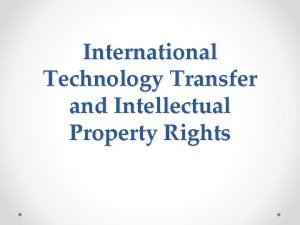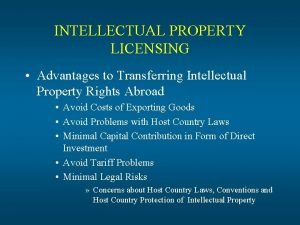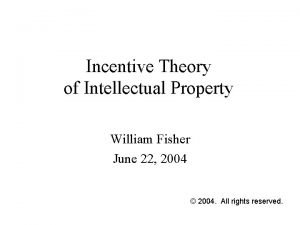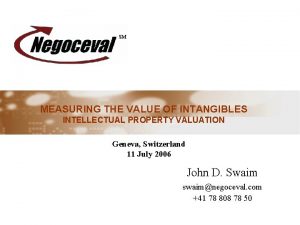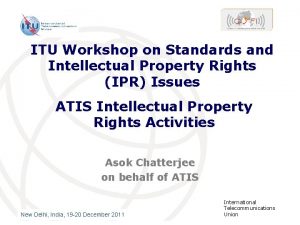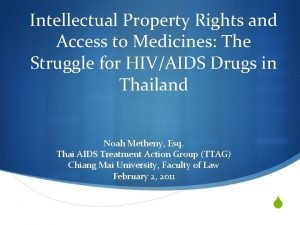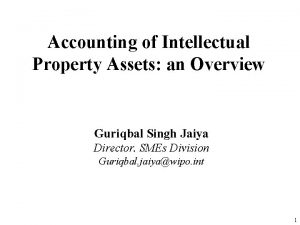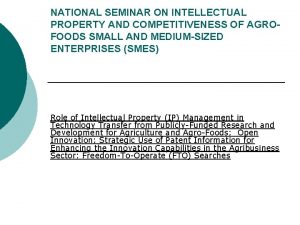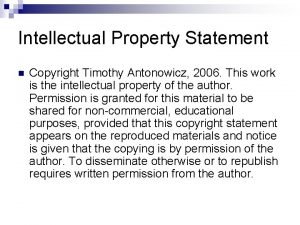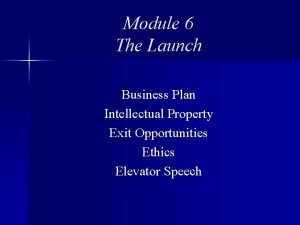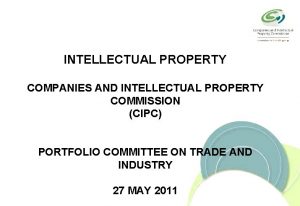Intellectual Property innovation and drugs for neglected diseases























- Slides: 23

Intellectual Property, innovation and drugs for neglected diseases James Love http: //www. cptech. org 13 March 2002

R&D is important, and costs money

What do companies spend on R&D?

7. 5 percent of sales

Pre-clinical research can be difficult, risky and costly

TB Alliance Report on economics of TB drug development • Drug Development Costs: – The costs--including the costs of failure--to develop a new chemical entity (NCE) to treat TB are estimated to be approximately $76 million to $115 million, including preclinical development, pharmaceutical development, and clinical trials. Including rough estimates of discovery brings the estimated total to between $115 million and $240 million (including the costs of failure). (All values are in U. S. dollars. )

Averages are misleading The costs of drug development vary greatly among products, for example on issues such as: • • The role of the government in paying for R&D The size (and cost) of clinical trials The time to market The difference between developing new drugs within a therapeutic class, as opposed to more novel products.

How to fund R&D?

Property rights in IP • Advantages – Works without appropriations – Decentralized decision making – Encourages risk taking • Disadvantages – – Excessive secrecy Ethical concerns over pricing Bargaining failures can block product development Under investment in public health priorities

Efforts to reexamine IPR system in high tech economy • • National Academy of Sciences FTC on IPR and antitrust EU debate over software patents Unrest among users – – – Research tools Future of music Free software movement Challenge to US copyright extension Access to public documents on the Internet Access to scientific journals

Collective intelligence • Eric Raymond’s the Cathedral and Bazaar broadened interest in the benefits of collaborative research models.

GNU General Public License (GPL) • For copyrighted materials, you can use freely even for commercial purposes, but must share modified code. • Efforts to extend to patent or data.

Tax Incentives • Advantages – Decentralized decision making • Disadvantages – Lack of transparency – Intellectual property rights not shared with public – Subsidies contrary to free trade principles

Public and donor funding • Advantages – Research can enter public domain – Donor can obtain intellectual property rights – Investments reflect public priorities – Greater transparency of investment flows • Disadvantages – Risks of bureaucratic inefficiencies – Risks of centralized decision making

Research Mandates • Cisplatin proposal • Taxol Proposal • Congressional proposals to increase health care R&D • Zimbabwe proposal

Proposal discussed at WHO Harare, Zimbabwe meeting on TRIPS & public health • Countries adopt systems of compulsory licensing of patents • Royalties on patents paid into a health care R&D fund. • Patent owners get shares in the fund. • Fund invests in research projects which address local needs

Trade agreement on R&D • Point of treaty should be increase innovation • Property rights would be means, not an end of the treaty • Countries would have obligations to share burdens of funding R&D for socially useful projects, focusing on global market failures

How would an R&D treaty differ from TRIPS? • Clinton/Blair agreement on funding sequencing of the human genome. • G 8 on research for neglected diseases • Public Access to Journals • Consider a much wider range of instruments • Models and standards for “technology transfer” agreements • Capacity building in the South

What can DND Working Group Do? • Recommend US and EU enter into agreements with WHO and other global bodies to use public rights in government funded R&D • Convene meeting with governments and other interested parties on R&D treaty. • Explore new R&D IP paradigms, including models based upon non-exclusive rights.

What can DNDi do? • Patent inventions • Consider patent pools with other like minded groups that support more open and public sharing of research • Avoid contracts and licenses which inhibit collaborative research or which lead to high prices. • Avoid secrecy in terms of contract terms.

Patent Pools • Lots of models • Could create a pool for those willing to share.

Article 1 of WTO TRIPS Agreement Nature and Scope of Obligations 1. Members shall give effect to the provisions of this Agreement. Members may, but shall not be obliged to, implement in their law more extensive protection than is required by this Agreement, provided that such protection does not contravene the provisions of this Agreement. Members shall be free to determine the appropriate method of implementing the provisions of this Agreement within their own legal system and practice.

For more information http: //www. cptech. org Subscribe to ip-health http: //lists. essential. org/mailman/listinfo/iphealth
 Innovation for the sake of innovation
Innovation for the sake of innovation Radical vs disruptive innovation
Radical vs disruptive innovation Trade related aspects of intellectual property rights
Trade related aspects of intellectual property rights Intellectual property in professional practices
Intellectual property in professional practices Importance of intellectual property
Importance of intellectual property Intellectual property management definition
Intellectual property management definition Advantages of intellectual property
Advantages of intellectual property Intellectual property business plan example
Intellectual property business plan example Property
Property Right to intellectual property of teachers
Right to intellectual property of teachers Industrial property definition
Industrial property definition Incentive theory
Incentive theory Concept of intellectual property
Concept of intellectual property Valuing intangible assets
Valuing intangible assets Intellectual property rights
Intellectual property rights Intellectual property rights
Intellectual property rights Characteristics of intellectual property
Characteristics of intellectual property Discuss intellectual property frankly
Discuss intellectual property frankly Intangible inputs
Intangible inputs Intellectual property
Intellectual property Intellectual property statement
Intellectual property statement Intellectual property business plan example
Intellectual property business plan example Evalueserve competitors
Evalueserve competitors Discuss intellectual property frankly
Discuss intellectual property frankly




